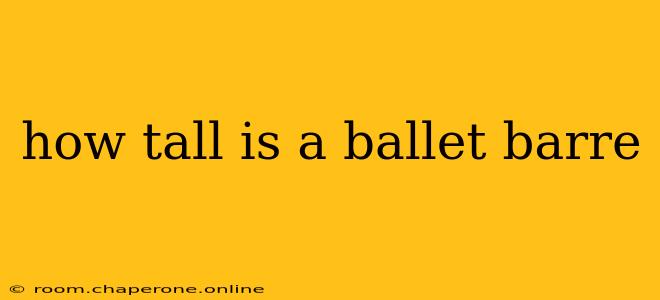The seemingly simple question, "How tall is a ballet barre?" reveals a surprisingly nuanced answer crucial for dancers of all levels. While there's no single, universally mandated height, understanding the typical range and the factors influencing barre height is vital for both dancer safety and effective technique. This article explores the standard ballet barre height, variations based on dancer age and experience, and the implications of improper barre height.
The Standard Ballet Barre Height
The most commonly accepted height for a ballet barre is between 35 and 40 inches (approximately 90 to 100 centimeters). This range allows dancers to comfortably perform exercises without straining their bodies or compromising their posture. This height ensures the dancer can hold onto the barre for support without hunching over or overextending their arms.
Factors Affecting Barre Height Variations:
Several factors contribute to the variations found within this seemingly narrow range:
-
Dancer Age and Height: For younger, shorter dancers, a lower barre might be more appropriate. As dancers grow and develop, the barre height may need adjusting to maintain optimal posture and technique. Adjustability is a key feature to look for in barre designs for studios and home use.
-
Dance Style: Some dance styles, particularly those that emphasize floor work or different techniques, might necessitate slight adjustments to the barre height for optimal transitions and exercises.
-
Individual Needs: Every dancer's body is unique, and personal preferences or physical limitations could also necessitate minor alterations to find the most comfortable and effective height.
The Importance of Correct Barre Height
Using a barre of the correct height offers several significant benefits:
-
Improved Posture: Proper barre height allows dancers to maintain an erect posture, preventing slouching and reducing the risk of back pain. A poorly positioned barre can lead to harmful compensatory movements.
-
Enhanced Technique: A correctly positioned barre allows for full range of motion and helps dancers execute exercises with precision and control, improving their overall technique.
-
Reduced Injury Risk: An appropriately sized barre reduces the strain on joints and muscles, minimizing the risk of injury from improper form or overexertion. A poorly chosen height can lead to pain and potentially more severe issues.
-
Increased Confidence: When a dancer feels secure and balanced at the barre, it increases their confidence and helps them focus more on the exercise rather than struggling with their positioning.
Choosing the Right Barre Height: Tips and Considerations
-
Consult with Instructors: Dance instructors are the best resource for determining the appropriate barre height for individual students. They can assess each dancer's needs and provide personalized recommendations.
-
Adjustable Barres: Investing in an adjustable barre allows for flexibility and accommodating the needs of dancers of different ages and heights.
-
Experimentation (With Supervision): Within a safe range, slight adjustments can be experimented with under the guidance of an experienced instructor to find the most comfortable and effective height.
-
Listen to Your Body: Pay attention to any discomfort or strain. If you experience pain, adjust the barre height or consult an instructor.
In conclusion, while the standard ballet barre height falls within a specific range, the ideal height is personalized and dependent on various factors. Prioritizing correct barre height is essential for the safety, well-being, and technical development of every dancer. Remember to always consult with a qualified dance instructor for personalized advice.

